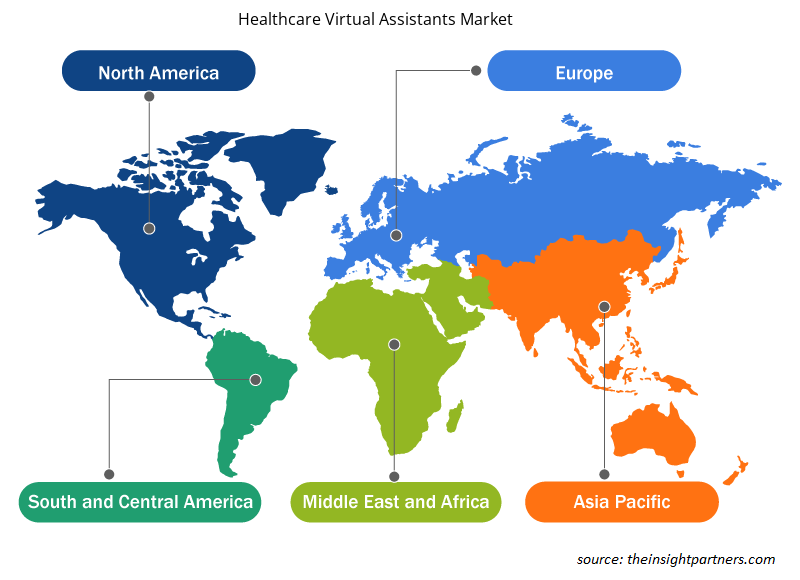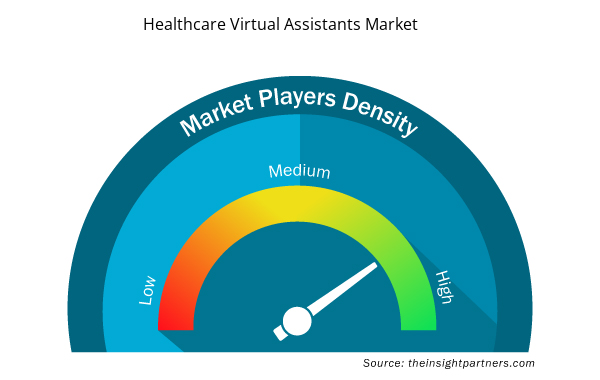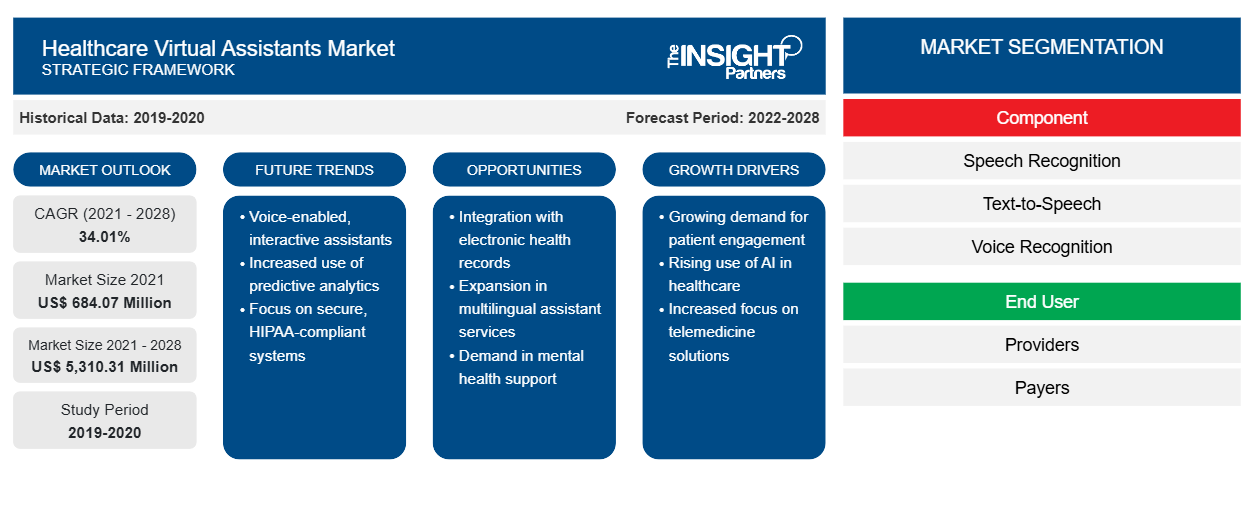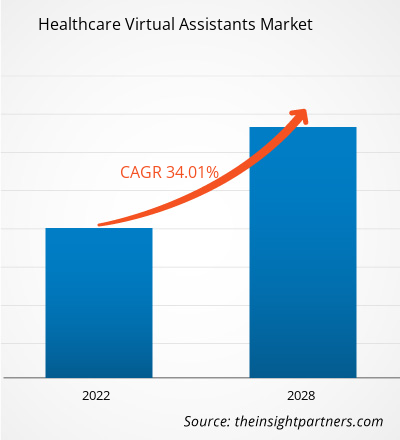[Forschungsbericht] Der Markt für virtuelle Assistenten im Gesundheitswesen soll von 684,07 Millionen US-Dollar im Jahr 2021 auf 5.310,31 Millionen US-Dollar im Jahr 2028 anwachsen; von 2021 bis 2028 wird ein durchschnittliches jährliches Wachstum von 34,01 % erwartet.
Zunehmende Entwicklungen und Fortschritte bei IT-Lösungen für das Gesundheitswesen und die zunehmende Verbreitung von Smartphones mit zunehmenden gesundheitsbezogenen Anwendungen stimulieren das allgemeine Marktwachstum. Laut einem Bericht der American Health Information Management Association ( AHIMA ) sind medizinische Fachkräfte zu einem Zielmarkt für Smartphone-Technologien geworden. In Gesundheitsorganisationen wie Krankenhäusern bieten moderne Smartphones mehr Komfort und Effizienz als herkömmliche Computer. Der Bericht der Weltgesundheitsorganisation (WHO) besagt, dass mobile Gesundheit ( mHealth ) die Gesundheitsergebnisse von Patienten revolutionieren und virtuelle Dienste über ein Smartphone mit medizinischem Fachwissen und Wissen in Echtzeit bereitstellen kann, was insbesondere für Menschen in abgelegenen Gebieten ein Segen ist.
Passen Sie diesen Bericht Ihren Anforderungen an
Sie erhalten kostenlos individuelle Anpassungen an jedem Bericht, einschließlich Teilen dieses Berichts oder einer Analyse auf Länderebene, eines Excel-Datenpakets sowie tolle Angebote und Rabatte für Start-ups und Universitäten.
- Holen Sie sich die wichtigsten Markttrends aus diesem Bericht.Dieses KOSTENLOSE Beispiel umfasst eine Datenanalyse von Markttrends bis hin zu Schätzungen und Prognosen.
Nordamerika wird voraussichtlich zwischen 2021 und 2028 weiterhin eine dominierende Stellung auf dem Markt für virtuelle Assistenten im Gesundheitswesen einnehmen. Die USA halten in dieser Region den größten Marktanteil. Aufgrund der entwickelten IT-Infrastruktur im Gesundheitswesen und staatlicher Initiativen zur Implementierung virtueller Assistententechnologien im Gesundheitswesen wird das Land im Prognosezeitraum voraussichtlich weiterhin ein dominanter Anteilseigner auf dem Markt sein. Darüber hinaus sind die USA der größte Markt für virtuelle Assistenten im Gesundheitswesen, vor allem aufgrund der hohen Nachfrage nach der Installation solcher fortschrittlicher Geräte in Krankenhäusern und Kliniken sowie in der häuslichen Pflege in den USA aufgrund der steigenden geriatrischen Bevölkerung. Abgesehen davon bietet die Präsenz wettbewerbsfähiger Top-Player in dieser Region mit ihren innovativen Produkteinführungen lukrative Möglichkeiten für das regionale Marktwachstum. Im Januar 2019 gaben das New-York Presbyterian Hospital und Philips eine Zusammenarbeit für virtuelle Assistenten im Gesundheitswesen bekannt. Das New-York Presbyterian Hospital hat geplant, seine virtuellen Pflegekapazitäten mit Fernüberwachungsdiensten von Philips zu erweitern.
Markteinblicke
Zunehmende Nutzung von Healthbots / Chatbots für eine qualitativ hochwertige Patientenversorgung treibt das Marktwachstum an
Die COVID-19-Pandemie ist ein eigenständiger Faktor, der für das Wachstum des gesamten Marktes für virtuelle Assistenten im Gesundheitswesen verantwortlich ist. Laut dem Bericht des Weltwirtschaftsforums ( WEF ) ist das Potenzial virtueller Assistenten enorm und mit lukrativen Vorteilen verbunden, die bereits realisiert werden. Daher bietet der Gesundheitssektor eine der umfassendsten Möglichkeiten für virtuelle Assistenten. Beispielsweise helfen automatisierte Texterinnerungen an Termine und Chatbot- Unterstützung Ärzten, über digitale Konsultationen mit Patienten in Kontakt zu treten. In Ruanda, wo es nur einen Arzt und sechs Gesundheitspersonal pro 10.000 Menschen gibt, tragen Gesundheitsbots dazu bei, den hohen Bedarf an Gesundheitspersonal zu verringern. In den kommenden Jahren werden Gesundheitsbots zum zentralen Werkzeug, indem sie KI nutzen, die für die ruandische Sprache und Epidemiologie lokalisiert ist, damit mehr Patienten zu Konsultationen behandelt werden können. Daher können durch solche virtuellen Assistenten eine effektive Nutzung knapper Gesundheitsressourcen erreicht und im Gegenzug die Qualität der Versorgung verbessert und Gesundheitspersonal auf dem Laufenden gehalten werden.
Komponentenbasierte Erkenntnisse
Basierend auf den Komponenten ist der Markt für virtuelle Assistenten im Gesundheitswesen in Spracherkennung, Text-to-Speech und Stimmerkennung unterteilt . Schätzungen zufolge wird das Segment Spracherkennung zwischen 2021 und 2028 den größten Marktanteil ausmachen. Die Spracherkennungstechnologie hat im Gesundheitssektor erhebliche Aufmerksamkeit erlangt. Laut dem Bericht der AHIMA Foundation begann der Gesundheitssektor mit der Implementierung von Spracherkennungstechnologie für medizinische Berichte. Mit kontinuierlichen Verbesserungen der Technologie wurde es für Krankenhäuser notwendig, dass sich Ärzte des Werts dieser Systeme bewusst wurden und an sie glaubten. In den kommenden Jahren könnte die Spracherkennungstechnologie auch eine wichtige Rolle dabei spielen, Gesundheitsdienstleistern dabei zu helfen , Dokumente am Krankenbett zu erstellen. Die oben genannten Faktoren treiben das Marktwachstum für das Spracherkennungssegment voran.
Erkenntnisse für Endbenutzer
Basierend auf dem Endnutzer ist der Markt in Anbieter, Kostenträger und andere segmentiert. Das Anbietersegment wird den Markt in den kommenden Jahren dominieren. Laut dem Bericht der American Telemedicine Association (ATA) bieten virtuelle Assistenten im Gesundheitswesen zahlreiche Vorteile für Patienten und Anbieter. Beispielsweise können Anbieter durch den Einsatz virtueller Assistenten ihre Reichweite erweitern, insbesondere für Patienten, die in ländlichen Gebieten leben, indem sie physische Barrieren bei der Versorgung beseitigen. Außerdem können sie präventive Dienste anbieten, die die Aufklärung oder das Wellness-Coaching der Patienten bei nicht dringenden Gesundheits- und Wellnessproblemen ermöglichen. Die virtuelle Ausweitung der Gesundheitsversorgung kann Anbietern dabei helfen, die Versorgung ihrer Patienten während ihrer Genesung nach einem längeren Krankenhausaufenthalt oder einem chirurgischen Eingriff zu überwachen und zu verwalten oder sogar als Ersatz für die persönliche Versorgung zu dienen, je nach den Bedürfnissen der Patientengruppe, den Möglichkeiten der Gesundheitsorganisation und der Ressourcenverfügbarkeit. Die oben genannten Faktoren tragen zum Marktwachstum im Anbietersegment bei.
Unternehmen, die auf dem Markt für virtuelle Assistenten im Gesundheitswesen tätig sind, verfolgen eine Produktinnovationsstrategie, um den sich weltweit entwickelnden Kundenanforderungen gerecht zu werden und so ihren Markennamen auf dem Weltmarkt zu behaupten.
Markt für virtuelle Assistenten im Gesundheitswesen – Segmentierung
Basierend auf den Komponenten ist der Markt für virtuelle Assistenten im Gesundheitswesen in Spracherkennung, Text-to-Speech und Stimmerkennung unterteilt. Nach Endbenutzer ist der Markt in Anbieter, Kostenträger und andere unterteilt.
Regionale Einblicke in den Markt für virtuelle Assistenten im Gesundheitswesen
Die regionalen Trends und Faktoren, die den Markt für virtuelle Gesundheitsassistenten im Prognosezeitraum beeinflussen, wurden von den Analysten von Insight Partners ausführlich erläutert. In diesem Abschnitt werden auch die Marktsegmente und die Geografie für virtuelle Gesundheitsassistenten in Nordamerika, Europa, im asiatisch-pazifischen Raum, im Nahen Osten und Afrika sowie in Süd- und Mittelamerika erörtert.

- Erhalten Sie regionale Daten zum Markt für virtuelle Assistenten im Gesundheitswesen
Umfang des Marktberichts zu virtuellen Assistenten im Gesundheitswesen
| Berichtsattribut | Details |
|---|---|
| Marktgröße im Jahr 2021 | 684,07 Millionen US-Dollar |
| Marktgröße bis 2028 | 5.310,31 Millionen US-Dollar |
| Globale CAGR (2021 - 2028)CAGR (2021 - 2028) | 34,01 % |
| Historische Daten | 2019-2020 |
| Prognosezeitraum | 2022–2028 |
| Abgedeckte Segmente | Nach Komponente
|
| Abgedeckte Regionen und Länder | Nordamerika
|
| Marktführer und wichtige Unternehmensprofile |
|
Marktteilnehmerdichte für virtuelle Assistenten im Gesundheitswesen: Auswirkungen auf die Geschäftsdynamik verstehen
Der Markt für virtuelle Assistenten im Gesundheitswesen wächst rasant. Dies wird durch die steigende Nachfrage der Endnutzer aufgrund von Faktoren wie sich entwickelnden Verbraucherpräferenzen, technologischen Fortschritten und einem größeren Bewusstsein für die Vorteile des Produkts vorangetrieben. Mit der steigenden Nachfrage erweitern Unternehmen ihr Angebot, entwickeln Innovationen, um die Bedürfnisse der Verbraucher zu erfüllen, und nutzen neue Trends, was das Marktwachstum weiter ankurbelt.
Die Marktteilnehmerdichte bezieht sich auf die Verteilung der Firmen oder Unternehmen, die in einem bestimmten Markt oder einer bestimmten Branche tätig sind. Sie gibt an, wie viele Wettbewerber (Marktteilnehmer) in einem bestimmten Marktraum im Verhältnis zu seiner Größe oder seinem gesamten Marktwert präsent sind.
Die wichtigsten Unternehmen auf dem Markt für virtuelle Assistenten im Gesundheitswesen sind:
- Nuance Communications, Inc.
- Amazon.com, Inc.
- Verient Systems, Inc.
- Microsoft Corporation
- Egain Corporation
Haftungsausschluss : Die oben aufgeführten Unternehmen sind nicht in einer bestimmten Reihenfolge aufgeführt.

- Überblick über die wichtigsten Akteure auf dem Markt für virtuelle Assistenten im Gesundheitswesen
Nach Geografie
Geografisch ist der Markt für virtuelle Assistenten im Gesundheitswesen hauptsächlich in Nordamerika, Europa, Asien-Pazifik, Naher Osten und Afrika (MEA) sowie Süd- und Mittelamerika unterteilt. Der Markt in Nordamerika ist weiter in die USA, Kanada und Mexiko unterteilt. Der europäische Markt für virtuelle Assistenten im Gesundheitswesen ist in Frankreich, Deutschland, Großbritannien, Spanien, Italien und den Rest von Europa unterteilt. Der Markt im Asien-Pazifik-Raum ist in China, Indien, Japan, Australien, Südkorea und den Rest von APAC unterteilt. Der Markt für virtuelle Assistenten im Gesundheitswesen im MEA ist weiter in Saudi-Arabien, die Vereinigten Arabischen Emirate, Südafrika und den Rest von MEA unterteilt. Der Markt in Süd- und Mittelamerika ist in Brasilien, Argentinien und den Rest von Süd- und Mittelamerika unterteilt.
Firmenprofile
- Nuance Communications, Inc.
- Amazon.com, Inc.
- Verient Systems, Inc.
- Microsoft Corporation
- EGAIN CORPORATION
- Infermedica
- CSS Corp
- Kognito
- Babylon
- True Imaging Interactive Inc.
- Historische Analyse (2 Jahre), Basisjahr, Prognose (7 Jahre) mit CAGR
- PEST- und SWOT-Analyse
- Marktgröße Wert/Volumen – Global, Regional, Land
- Branche und Wettbewerbsumfeld
- Excel-Datensatz



Report Coverage
Revenue forecast, Company Analysis, Industry landscape, Growth factors, and Trends

Segment Covered
This text is related
to segments covered.

Regional Scope
North America, Europe, Asia Pacific, Middle East & Africa, South & Central America

Country Scope
This text is related
to country scope.
Häufig gestellte Fragen
Growing prevalence of chronic diseases and increasing social networking and smart phone users are the most significant factors responsible for the overall market growth.
Based on component, speech recognition segment took the forefront lead in the worldwide market by accounting largest share in 2020 and is expected to continue to do so till the forecast period.
A healthcare virtual assistant is an innovative technology which helps with administrative and customer support tasks such as digitizing health history forms, electronic medical record (EMR/EHR) data management, patient appointment scheduling, medical authorizations, eligibility processing, and medical billing.
The providers segment dominated the global healthcare virtual assistants’ market and accounted for the largest market share of 51.53% in 2021.
Global healthcare virtual assistants’ market is segmented by region into North America, Europe, Asia Pacific, Middle East & Africa, and South & Central America. In North America, the U.S. is the largest market for fall management market. The US is estimated to hold the largest share in the healthcare virtual assistants’ market during the forecast period. The presence of top players and favorable regulations related to product approvals coupled with commercializing new products are the contributing factors for the regional growth. Additionally, the increasing number of R&D activities is the key factor responsible for the Asia-Pacific regional growth for healthcare virtual assistants accounting fastest growth of the region during the coming years.
Nuance Communications, Inc.; Amazon.com, Inc.; Verient Systems, Inc.; Microsoft Corporation; EGAIN CORPORATION; Infermedica; CSS Corp; Kognito; Babylon; and True Image Interactive Inc. are among the leading companies operating in the global healthcare virtual assistants’ market
Trends and growth analysis reports related to Technology, Media and Telecommunications : READ MORE..
The List of Companies - Healthcare Virtual Assistants Market
- Nuance Communications, Inc.
- Amazon.com, Inc.
- Verient Systems, Inc.
- Microsoft Corporation
- Egain Corporation
- Infermedica
- CSS Corp
- Kognito
- Babylon
- True Image Interactive Inc.
The Insight Partners performs research in 4 major stages: Data Collection & Secondary Research, Primary Research, Data Analysis and Data Triangulation & Final Review.
- Data Collection and Secondary Research:
As a market research and consulting firm operating from a decade, we have published and advised several client across the globe. First step for any study will start with an assessment of currently available data and insights from existing reports. Further, historical and current market information is collected from Investor Presentations, Annual Reports, SEC Filings, etc., and other information related to company’s performance and market positioning are gathered from Paid Databases (Factiva, Hoovers, and Reuters) and various other publications available in public domain.
Several associations trade associates, technical forums, institutes, societies and organization are accessed to gain technical as well as market related insights through their publications such as research papers, blogs and press releases related to the studies are referred to get cues about the market. Further, white papers, journals, magazines, and other news articles published in last 3 years are scrutinized and analyzed to understand the current market trends.
- Primary Research:
The primarily interview analysis comprise of data obtained from industry participants interview and answers to survey questions gathered by in-house primary team.
For primary research, interviews are conducted with industry experts/CEOs/Marketing Managers/VPs/Subject Matter Experts from both demand and supply side to get a 360-degree view of the market. The primary team conducts several interviews based on the complexity of the markets to understand the various market trends and dynamics which makes research more credible and precise.
A typical research interview fulfils the following functions:
- Provides first-hand information on the market size, market trends, growth trends, competitive landscape, and outlook
- Validates and strengthens in-house secondary research findings
- Develops the analysis team’s expertise and market understanding
Primary research involves email interactions and telephone interviews for each market, category, segment, and sub-segment across geographies. The participants who typically take part in such a process include, but are not limited to:
- Industry participants: VPs, business development managers, market intelligence managers and national sales managers
- Outside experts: Valuation experts, research analysts and key opinion leaders specializing in the electronics and semiconductor industry.
Below is the breakup of our primary respondents by company, designation, and region:

Once we receive the confirmation from primary research sources or primary respondents, we finalize the base year market estimation and forecast the data as per the macroeconomic and microeconomic factors assessed during data collection.
- Data Analysis:
Once data is validated through both secondary as well as primary respondents, we finalize the market estimations by hypothesis formulation and factor analysis at regional and country level.
- Macro-Economic Factor Analysis:
We analyse macroeconomic indicators such the gross domestic product (GDP), increase in the demand for goods and services across industries, technological advancement, regional economic growth, governmental policies, the influence of COVID-19, PEST analysis, and other aspects. This analysis aids in setting benchmarks for various nations/regions and approximating market splits. Additionally, the general trend of the aforementioned components aid in determining the market's development possibilities.
- Country Level Data:
Various factors that are especially aligned to the country are taken into account to determine the market size for a certain area and country, including the presence of vendors, such as headquarters and offices, the country's GDP, demand patterns, and industry growth. To comprehend the market dynamics for the nation, a number of growth variables, inhibitors, application areas, and current market trends are researched. The aforementioned elements aid in determining the country's overall market's growth potential.
- Company Profile:
The “Table of Contents” is formulated by listing and analyzing more than 25 - 30 companies operating in the market ecosystem across geographies. However, we profile only 10 companies as a standard practice in our syndicate reports. These 10 companies comprise leading, emerging, and regional players. Nonetheless, our analysis is not restricted to the 10 listed companies, we also analyze other companies present in the market to develop a holistic view and understand the prevailing trends. The “Company Profiles” section in the report covers key facts, business description, products & services, financial information, SWOT analysis, and key developments. The financial information presented is extracted from the annual reports and official documents of the publicly listed companies. Upon collecting the information for the sections of respective companies, we verify them via various primary sources and then compile the data in respective company profiles. The company level information helps us in deriving the base number as well as in forecasting the market size.
- Developing Base Number:
Aggregation of sales statistics (2020-2022) and macro-economic factor, and other secondary and primary research insights are utilized to arrive at base number and related market shares for 2022. The data gaps are identified in this step and relevant market data is analyzed, collected from paid primary interviews or databases. On finalizing the base year market size, forecasts are developed on the basis of macro-economic, industry and market growth factors and company level analysis.
- Data Triangulation and Final Review:
The market findings and base year market size calculations are validated from supply as well as demand side. Demand side validations are based on macro-economic factor analysis and benchmarks for respective regions and countries. In case of supply side validations, revenues of major companies are estimated (in case not available) based on industry benchmark, approximate number of employees, product portfolio, and primary interviews revenues are gathered. Further revenue from target product/service segment is assessed to avoid overshooting of market statistics. In case of heavy deviations between supply and demand side values, all thes steps are repeated to achieve synchronization.
We follow an iterative model, wherein we share our research findings with Subject Matter Experts (SME’s) and Key Opinion Leaders (KOLs) until consensus view of the market is not formulated – this model negates any drastic deviation in the opinions of experts. Only validated and universally acceptable research findings are quoted in our reports.
We have important check points that we use to validate our research findings – which we call – data triangulation, where we validate the information, we generate from secondary sources with primary interviews and then we re-validate with our internal data bases and Subject matter experts. This comprehensive model enables us to deliver high quality, reliable data in shortest possible time.


 Holen Sie sich ein kostenloses Muster für diesen Bericht
Holen Sie sich ein kostenloses Muster für diesen Bericht